
This blog post is part of a series on our Good Problems team. Each post looks at a different step in the process of designing a funding programme and makes suggestions about how to optimise to achieve a greater impact.
Of all the problems facing the world, how do funding organisations pick one to focus on?
Identifying a problem to fund is a huge responsibility. Whether you’re a charity, foundation, funding agency or philanthropic organisation, the problem you choose will mobilise and energise people, it will focus their attention and interests, and it will use up their time and resources. It’d better be a good problem.
Finding a good problem to focus on may seem straightforward. There are so many problems out there that it’s almost ridiculous to think that finding a good one to focus on might be a challenge. But it’s precisely this abundance that makes identifying good problems difficult. It creates the impression that focusing on anything is likely to be of some use to someone. But when you’re dealing with increasingly limited resources and a growing pressure to demonstrate impact, identifying a good problem becomes essential.
In this post we’re outlining some of the things we found to be of help in this process - from defining a ‘good problem’, to creating engaging stimulus materials and using them in conversations with domain experts, users or potential solvers to gather feedback.

Defining a Good Problem
When you start scouting for a good problem it is extremely useful to have a set of criteria to search for. This will help set priorities, structure research, and shape conversations with formal or informal advisors. Here is our list of criteria for what makes a good problem.
-
A good problem identifies a real obstacle to be overcome. The challenge here is being able to make a distinction between the root-cause and a symptom of a problem. Misdiagnosed problems often end up being only symptoms of larger, poorly understood problems. Trying to address these symptoms brings limited value as it ultimately fails to solve the underlying issue. A good problem will identify an actual barrier that, if addressed, can enable progress.
-
A good problem is worthwhile. The ‘worth’ of a problem is dependent on a funding organisation’s desired impact. This can be anything from a positive impact on a specific group of people, to a significant advancement of scientific knowledge. A good problem, when solved, will unlock the type and scale of impact sought by the funder.
-
A good problem is timely. Problems are not defined in isolation. A good problem is one where current external factors – political, economic, legal, social – are not barriers, but are conducive to innovation and positive change. A good problem will take advantage of technological advancements, but will also be aware of their constraints.
-
A good problem draws together a community of solvers. A good problem should provoke and incite curiosity. Regardless of the topic, a good problem will have some aspect that will entice an existing or new community of solvers to come up with new ideas and work on refining them into viable solutions.
-
A good problem is one that a funding organisation can do something about. Even though a problem may be ‘good’ according to the above criteria, it is important that funding organisations appreciate whether the problem is good for them and whether they are best placed to do something about it. This means making sure that they have the relevant funding, capacity, networks, or convening power necessary to support and incentivise problem-solving.
While the above are a good starting point for defining a good problem, these criteria will need to be adjusted and expanded on to match the vision, ambitions, and resources of a funding organisation.
For instance, for our project around designing Tech Challenge Prizes for the European Commission Horizon’s 2020 Programme, we looked for problems that focused on technological limitations, had a significant European impact, and could be solved by launching a multi-million EUR prize. For our work with The Humanitarian Innovation Fund we identified problems related to the adequate provision of water, sanitation and hygiene in the specific context of a humanitarian emergency.
Having a clear understanding, from the beginning, of what makes a good problem helps narrow and focus research. Instead of investing time and effort into evaluating problems that might not be suitable for a funding organisation, resources can be directed towards investigating the suitability of relevant and impactful problems.
Investigating a Good Problem
To build an accurate understanding of a problem we speak with a wide range of stakeholders. By ‘stakeholders’ we mean people who are either directly affected by the problem, involved in researching it, or working on building solutions.
This process can quickly become overwhelming as stakeholders can have different, often conflicting opinions about a problem. To overcome this challenge and make the most out of the feedback received we stick to three guiding principles:
-
Create an engaging stimulus and focus conversations around it. There are many variables to consider when speaking with different stakeholders - various backgrounds, interests, cultures, and perspectives. Having a constant in these conversations can help make sense of feedback, structure it, and act on it. In our conversations, this constant is often a stimulus material that reflects our understanding of a problem. This stimulus can be anything from a document, to a visual map of a problem and the barriers preventing its resolution. Its design depends on how well the problem is defined and the level of feedback we’re interested in gathering. We share these materials with people during interviews or workshops and ask them to help us fill out gaps and validate or disprove assumptions.
-
Update the stimulus when you start hearing repetitive feedback. We speak with a variety of stakeholders because we want to get a balanced view of a problem. After a number of conversations using the same stimulus, patterns will begin to emerge. Changes that we need to make to the materials will become obvious, while new questions about the problem will appear. At this point, we update the materials to reflect our latest understanding of the problem and focus conversations on the new questions.
-
Keep track of feedback and decisions made. Using a stimulus makes it easier to record feedback and group it around specific aspects of a problem. This makes it easier to communicate divergent views and reach a consensus about next steps. We found that having a transparent record of feedback received and decisions made is incredibly useful as it offers a clear and evidence-based justification for the focus on a particular problem. It can also encourage open conversations around the desired impact of a funding organisation and the extent to which focusing on a particular problem is going to achieve that impact.
While these principles make the process of engaging with stakeholders and validating a problem easier, it’s never easy. It takes practice to learn how to design an engaging stimulus, what questions to ask, how to collate feedback, and how to act on it. Every community will be different, but collaboration is crucial to identifying a problem worth solving.
Funding organisations are under increasing pressure to evaluate and demonstrate the impact of their funding programmes. This pressure comes from an increased scrutiny from donors, a diminishing of resources, and an increase in the scale of the challenges they face. Most organisations try to measure the impact of their programmes after the moment they allocate funds. But funders might find that they are able to access a great deal of untapped potential by improving the way that they identify good problems.
The first thing we do when we start working on a project that covers a topic new to us is understand and assimilate the vocabulary and its different nuances. This introduction to a problem area can be a smooth one where key terminology and concepts are clearly defined, or it can be a bumpier ride. In these cases, it becomes part of our task to make sense of conflicting definitions and propose a consensus in order to advance dialogue.
In all honesty, none of the problem areas we have worked on were really smooth rides. While key concepts may have clear definitions, the context of our work is to encourage new thinking around problems. This often means encouraging a new language or vocabulary. A perfect example of this is our work around gender-based violence interventions.
In 2016 we worked together with the Humanitarian Innovation Fund (HIF) to help them design a number of innovation challenges. The aim of these challenges was to encourage solutions to some of the most pressing problems faced during humanitarian emergencies. One of these problems was Gender-based violence (GBV).
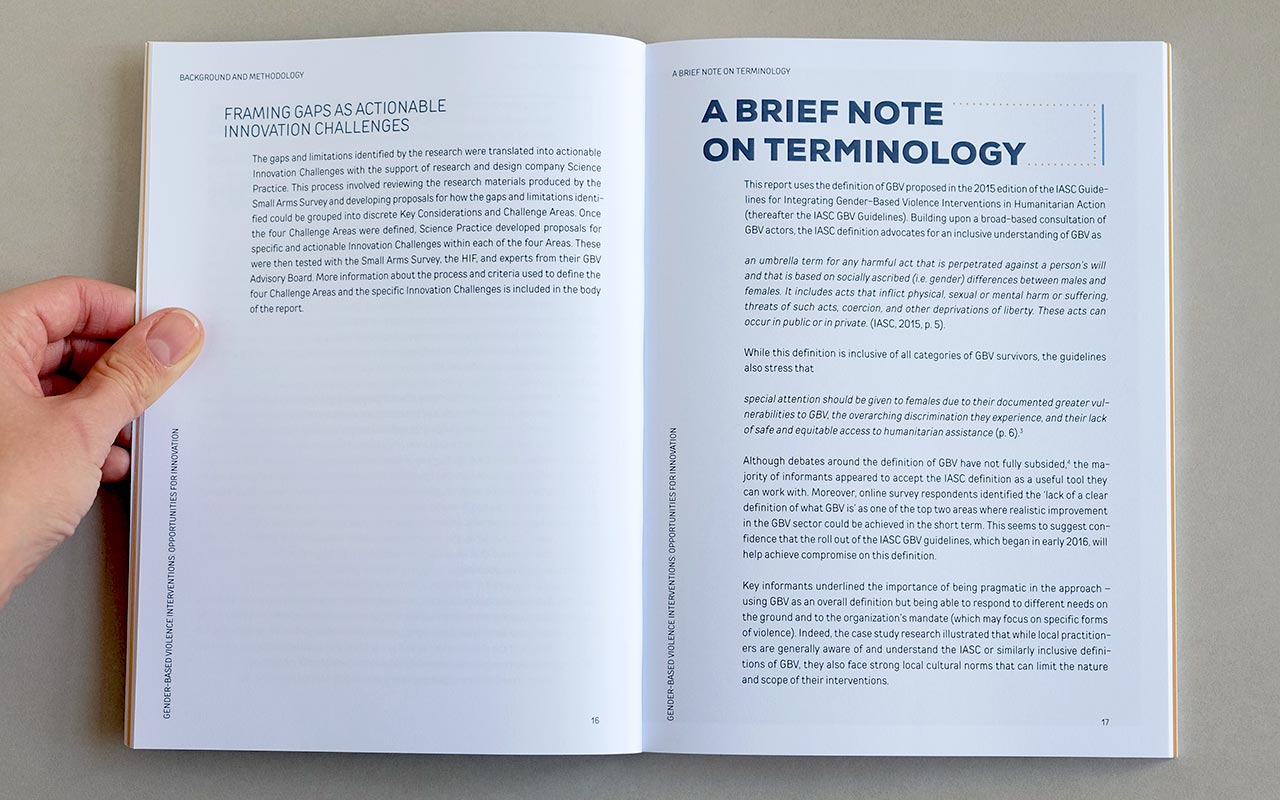
Forward note on terminology in the GBV Gap Analysis Report. We helped the HIF edit the report and Poważne studio helped design it. Read more about the project on our GBV Challenges page.
Gender-Based Violence
Most relevant in this case, IASC GBV Guidelines define GBV as “an umbrella term for any harmful act that is perpetrated against a person’s will and that is based on socially ascribed (i.e. gender) differences between males and females.” This definition is purposefully open to be inclusive of all categories of GBV survivors including men, boys, and the LGBTI community. Still, the guidelines stress that females should be given special consideration due to their documented greater vulnerability to GBV, especially in a humanitarian context.
Despite this emphasis, the change in perspective to adopt a more inclusive definition of GBV has generated tensions. Advocates for GBV as a female-centric issue argue that they have fought hard to get people and funders to pay attention to the topic within the context of humanitarian emergencies. Their concern is that now that the topic is gaining increasing attention, broadening the focus of GBV to include men or the LGBTI community would lead to a dilution of this message, and most significantly, a dilution of the funding allocated to the cause.
The lack of consensus on the definition of GBV had two consequences:
-
it was difficult to have a clear delimitation of the problem
-
it was difficult to move conversations beyond this point.
This problem was often flagged up by the research partners on the project, the Small Arms Survey. Doing research on the ground, they noticed that the lack of a common definition for GBV led to disagreements and used up valuable resources.
We weren’t in a position to provide an answer to the debate, but it became obvious that focusing on language on its own wasn’t going to lead to any progress. So we made a decision to move the conversation a step forward.
We acknowledged the different perspectives and decided to adhere to the broad definition proposed by IASC GBV Guidelines. As the role of the challenges we were designing was to open up problems in the GBV humanitarian emergency sector to a wider group of people and skills, this definition felt appropriate and timely. It also set the tone for the challenges as it implied an inclusive way of approaching the problem, one that required a new and open language. This decision allowed us to move beyond the stalemate and refocus the conversation on concrete barriers that are holding back progress.
Innovation in a GBV Context
The term ‘innovation’ presented a different provocation. The problem with the term ‘innovation’ is that it has been overused and so often misused that it’s lost meaning. The problem with using it in the context of GBV was that it was seen by some as frivolous.
But innovation is not about gadgets or high-tech solutions, it’s about adding value. Innovation is about creating something new – whether it’s a product, service, or approach – that adds value and leads to an improvement of a current situation.
It was this definition and idea that the HIF were keen to communicate through the challenges. Their goal was to not only reestablish the meaning of ‘innovation’, but also create a place for it in the space of humanitarian emergencies.
Our contribution to this process was to make sure the innovation challenges we were designing were targeting real and significant problems and would support the development of genuine and valuable solutions. While our role was to offer a new perspective on core problems and engage a broader audience of problem-solvers, we wanted to make sure that we were presenting a balanced view of the complexities entailed by each challenge and avoided oversimplifications.
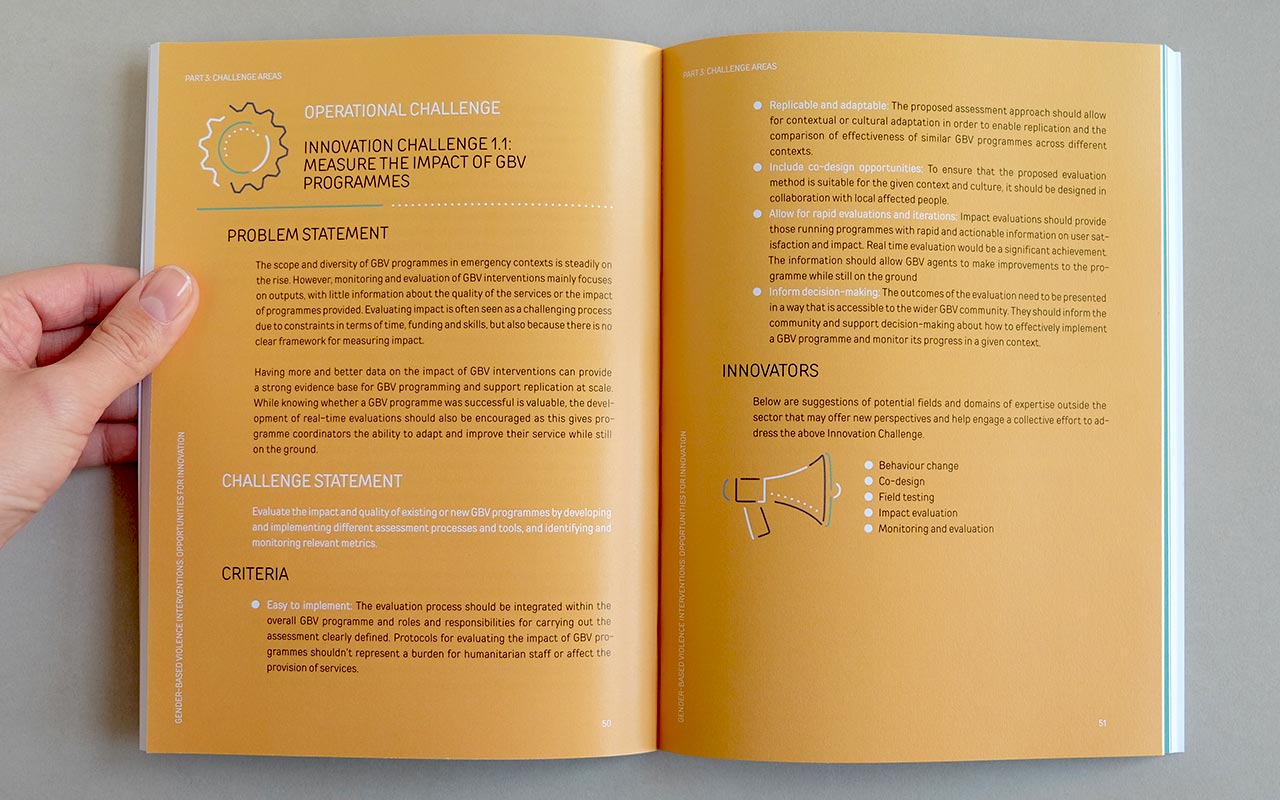
Sample Innovation Challenge looking at measuring the impact of GBV programmes in humanitarian emergencies. See full GBV Gap Analysis Report.
One other important aspect that we became aware of was that the ‘novelty’ implied by ‘innovation’ is context dependent. Having worked mainly on designing challenges where solutions were non-existent because of current technological limitations, we were used to ‘novel’ as meaning ‘new to the world’. However, for problems faced in the humanitarian sector, solutions often exist but they are not suitable for a space with limited resources. ‘Novelty’ here can mean creating completely new solutions, but it can also mean adapting existing solutions to a humanitarian context and be just as valuable.
It was through this lens that we designed the innovation challenges. While most of the problems identified were not necessarily new or unknown to GBV practitioners, what was novel about them was the perspective from which they were presented, the clarity with which they set priorities for action, and the different audiences they were targeted at.
Defining the terms we use when working on a new problem area will always be a priority for us. What we’ve learned from this project is that, sometimes, definitions are not readily available but need to be considered and constructed as part of the innovation process. In these cases, the ambition goes beyond that of designing innovation challenges and becomes that of creating a language that can support a new way of thinking and collaborating around problems.
This year Science Practice has been moonlighting in the world of social innovation and humanitarian aid through our work with the Humanitarian Innovation Fund (the HIF). We learned a lot about social innovation funding methods from our work with the HIF and want to understand if any of our learnings could translate to the domains of funding for science.
A brief tour of social innovation funding models
Social innovation is defined as a novel solution to a social problem that is more effective, just, efficient or sustainable than current solutions. In other words, the value created should benefit society rather than individuals. With this definition in mind, many of the world’s most recognised foundations including the Rockerfeller Foundation and the Bill & Melinda Gates Foundation have been using different funding models to facilitate innovation to best achieve their social aims. The dominant method of funding over the last 20 years is the strategic model, which is defined by a process of outlining clear goals and advocating for data-driven strategies, accountability and evaluation. The approach was developed to support funders to align their programs and grant-making with carefully designed theories of change to produce clear and quantifiable results. The strategic model aims to be strongly predictive of the end results. So, while the model works well to address clear cut problems (like building a hospital), it tends to fall short when addressing the complex problems (like population health, water shortages and food security) we are challenged with today.
To cover these shortcomings, a new “emergent approach” has surfaced. The use of the word “emergent” suggests that an organisation is actively learning what works in practice. In doing so, the approach promotes iteration, failure, learning and knowledge development. There is no pre-determined point of view or a dominant idea of an answer to a problem. Instead, emergence encourages the input from novel ideas, processes and people.
At Rockerfeller, this approach starts with applying the same rigor and critical thought to framing a problem area as it does to evaluating the success of a grant. The foundation’s “Search” function is a highly strategic, analytical process that involves the coordination of internal staff, consultants, and nearly 200 outside experts to help the foundation appropriately frame a problem space. This includes an understanding of interlinking and underlying issues that must be considered in order to find a solution. This process is not dissimilar to Science Practice’s own process of identifying Good Problems. To anyone at Rockerfeller who might be reading this, it would be good to share notes!
New models to fund social innovation are gaining traction. Venture philanthropy aims to build self-sustaining or even profitable enterprises in unlikely places such as disaster relief or drug addiction. Social Impact Bonds (SIB) channel private funding into social initiatives and are backed by the British government who pays interest that rises and falls with the success of the venture. If the initiative fails to fulfill its social aims, investors will simply pursue other opportunities.
What science funding can learn from social innovation
Social Innovation funders (like the HIF) generally have a very clear idea of what change they want to see in the world and apply funding to achieve that vision. In comparison, some science funders, work across a broad remit. With big aims like the Medical Research Council’s desire to “improve human health through world-class medical research”, it’s less clear how science funding is allocated to achieve such goals and objectives.
Since the publication of the Warry Report in 2006, UK science funders have worked to better understand the link between scientific research and economic and societal impact. Factors including political pressure, genuine need and increasing impatience with the pace of scientific discovery have encouraged a renewed focus on supporting research with “impact”. This has helped to shape a shift in trajectory of scientific funding towards translational research. Here, lessons from social innovation can help us to think differently about how science funding is allocated and its impact measured.
Considering that translational research is an area where the development timelines can be long, intermediate indicators of progress are needed. To do this, funders could support teams of researchers working to better coordinate knowledge across basic and translational research. Like the “emergent” approach in social innovation, funders could distribute monies, measure and evaluate the intermediate indicators and adjust future funding accordingly.
To do this effectively, funders would need to be much more opinionated about identifying specific research goals to target and be more strategic about how resources should be spent in achieving such aims. But looking at the Medical Research Council’s study on “Measuring the link between research and economic impact” it’s clear that funders might not have sufficient data to understand what proportion of translational output arises from strategic initiatives- ongoing funding schemes in specific areas- and how much is shaped by the “response mode”, a more flexible funding call. A better understanding of what works when it comes to shaping funding schemes and cycles in science research funding would be an excellent place to start (and something we would be really keen to explore).
Processes that are expected to accelerate translation include such things as a good collaborative culture. The more recent development of research sandpits- a facilitated workshop where participants from different disciplines, work in small groups to brainstorm and refine ideas for joint research projects- are being promoted across research councils, universities and big funders. Promoted as a new, innovative way to allocate funds, it’s unclear if the strategy is working and if not, there is little insight on how they could be improved. Better data on the effectiveness of collaborative processes in science and their ability to contribute to more impactful research are needed.
There has been renewed focus on the contribution of venture philanthropy in science R&D. The influence of nonprofits in shaping new models to allocate funds is of note. The Association of Medical Research Charities estimates that nonprofits contribute £1.3bn to the UK’s academic research base, a considerable chunk of change. But medical research charities are looking for new innovative and entrepreneurial models of funding research and are taking greater risks in hopes of discovering the next cure.
Taking a cue from their American sister organisation, the Cystic Fibrosis Foundation, the UK’s Cystic Fibrosis Trust, who used to place all its funds raised into academic research, are now seed-funding biopharma. Investment in biotechnology startups they admit, comes with significant risk, but potentially greater reward when aiming for a cure. The funding the Trust does allocate to academic research has been re-engineered to promote a larger pool of ideas and has established new way of collaborative working across their research base. The In addition, the Trust aims to take the money donated and amplify it with the establishment an Investment Fund to unlock additional sources of money to support scientific breakthroughs.
So, as funding for social innovation transitions to be more responsive to the needs presented by complex, global challenges it appears science funding is in a state of transition too. Each acknowledge that traditional grant making may be too rigid and are challenging the prescriptive allocation of funds with structures that support risk, investment in new business models and a more iterative, responsive approach to understand what’s working. How this shift in science challenges the support for blue skies research and discovery for discovery’s sake (which is something we really believe in) has yet to be fully measured and understood.
We are really interested to learn more about innovation in science research and social innovation funding. We are keen to collaborate with individuals and organisations who want to actively explore some of the ideas presented in this post.
What are we trying to get them to do with this activity? Will it take too long? What if we work backwards from the application form? What is the main message of the day? How can we encourage iterative thinking?… We need how many post-its?!
We had a lot of questions.
The aim of these questions was to help us design the launch event of the Humanitarian Innovation Fund (HIF)’s Surface Water Drainage Challenge. Over the past couple of months we’ve been working together with the HIF to help them design six challenges in emergency Water, Sanitation and Hygiene (WASH). The scope of this event was to raise awareness of a relatively overlooked challenge in the humanitarian sector, encourage collaborations, and support the development of strong proposals.
This wasn’t the first event we were organising, but it was definitely one of the largest and most open ones. We’re used to designing and running expert workshops where we present a version of what we think a challenge or a prize could look like and then get ready for the experts to tear it apart and help us build a better one. We’re confident with this process as it involves us asking the questions and getting feedback on a clearly defined output. This was something else.
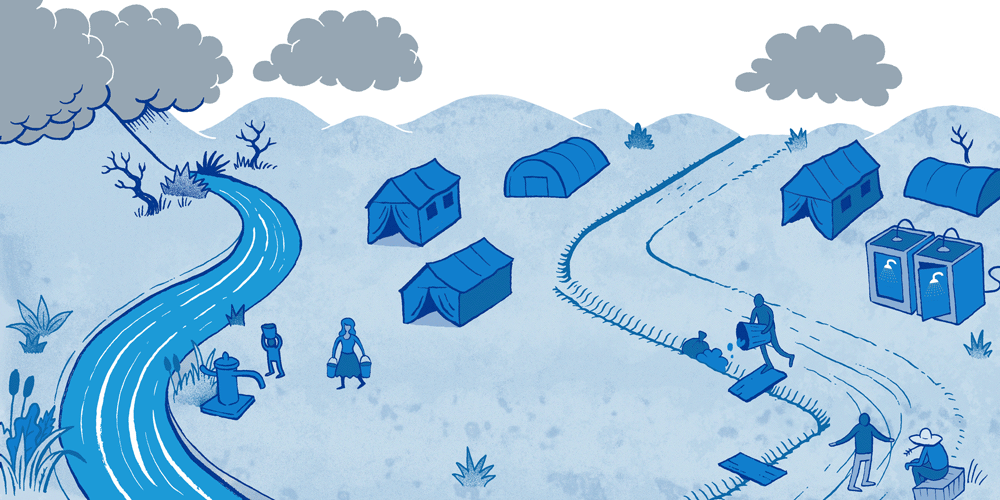
Causes, effects and potential solutions for Surface Water Drainage in a humanitarian emergency.
Surface Water Drainage (SWD) is an important but rarely addressed issue in a humanitarian emergency. Surface water pooling can be a result of storms or overflowing rivers, as well as poor drainage around water tap stands or water tanks. This water can have a major impact on people’s health but also on their self-esteem and dignity. Having to address this problem in an emergency represents additional challenges because of limited funding, available technical skills and time.
Through several rounds of expert engagement and iterations we developed the Surface Water Drainage Challenge Statement. Now, all we had to do was launch it.
.@the_hif's very own @menka lays out the compelling need for innovation in the humanitarian sector. pic.twitter.com/Qd1cElFx7Z
— Kim Scriven (@KimScriven) April 5, 2016
Shaping ideas to improve drainage in humanitarian emergencies. @The_HIF #unblocking innovation pic.twitter.com/GAWu7glLou
— Science Practice (@sciencepractice) April 5, 2016
The Launch
There are many ways to launch a Challenge. These can range from large public-facing events, to the simple publishing of a call for proposals on a site. Deciding on the best suited approach depends on the aims of the Challenge, the types of solutions sought, likely number of applicants, and the resources available. In the case of the SWD Challenge, we decided to hold a small ideation workshop with key stakeholders and potential applicants (around 30-40 people). The aim was to meet the following objectives:
-
Create a shared understanding of the problem: SWD is not a well-understood problem among humanitarian practitioners, let alone those outside the sector. To help raise awareness of this challenge we brought together drainage experts, researchers, consultants, product manufacturers, designers and humanitarian practitioners, to share their experiences, their understanding of the problem, and in doing so, develop a common understanding of it.
-
Encourage the development of collaborations: Because of the complexity of the problem of SWD in emergencies, we wanted to emphasize on the need to develop robust and diverse teams with a wide range of skills and expertise that could effectively try to tackle the challenge. By bringing people from different backgrounds in the same room, and encouraging them to think about solutions together, we wanted to facilitate the process of developing successful collaborations.
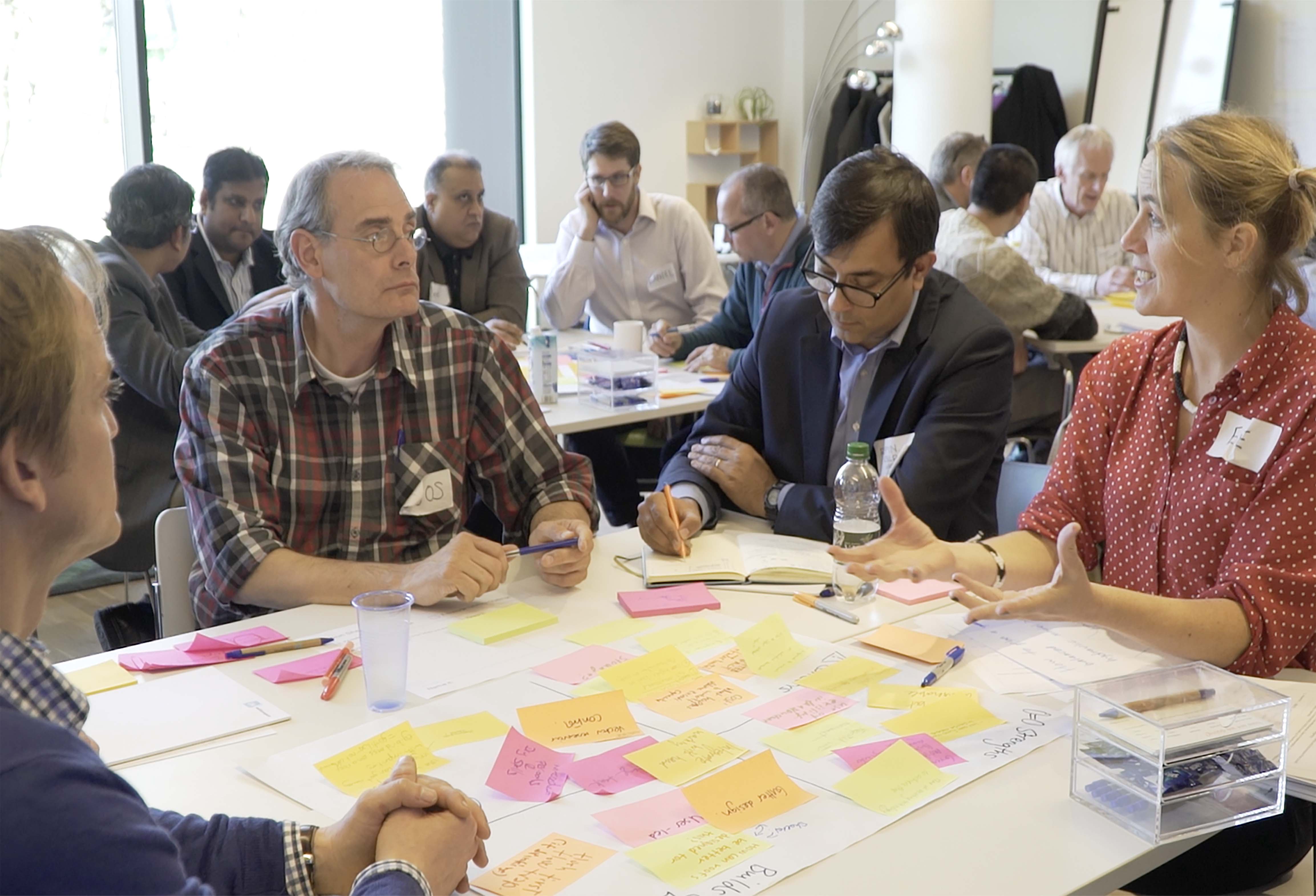
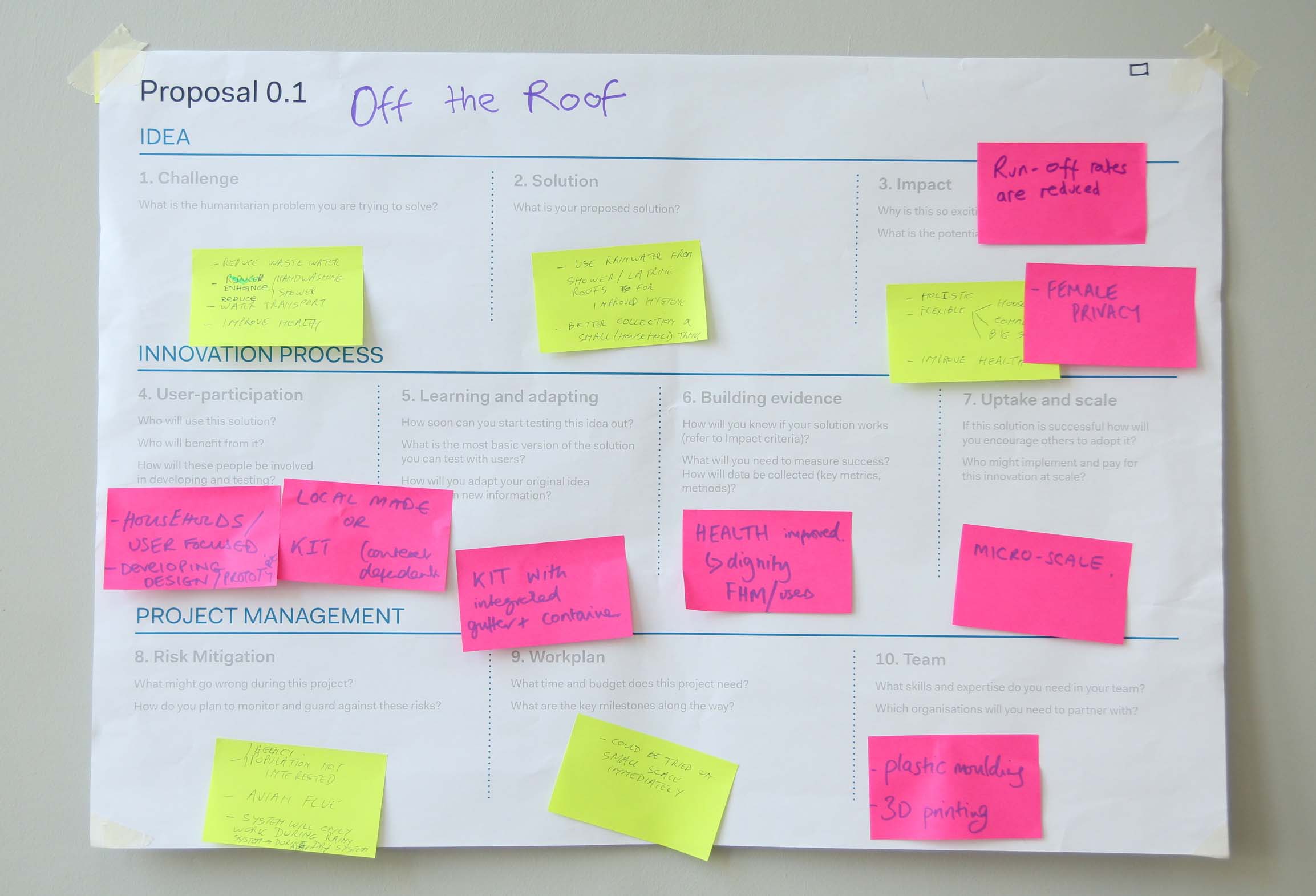
Ideas generated at the launch can be found on the HIF's SWD Challenge Page and here (.pdf).
-
Encourage a design-thinking approach: The HIF were keen to push applicants to think in a more iterative approach about developing solutions. To do so we helped them simplify the application form, made it more concise and emphasized two key elements - user engagement, and learning and adapting. The focus on user engagement implied that involving users in the initial phases of developing solutions was a core requirement, while the focus on learning and adapting asked applicants to think about how to best integrate the feedback received and build upon it. These two elements were also included in the design of the workshop, where participants were asked to come up with potential project ideas, get feedback from the group, iterate, and then receive feedback from a panel of mentors.
-
Familiarise participants with the application process: The risk in simply launching a call for proposals is that applicants often have a template form or a specific solution in mind that they will try to fit around the new call. Having a workshop launch meant that we had an opportunity to present the specific details of the challenge, answer questions and give clarifications. We could highlight the types of solutions the HIF were interested in seeing, and the core elements to focus on when submitting the application. Ultimately, the most important objective for the HIF was to receive strong proposals.
We've been at the @The_HIF launch of the Surface Drainage Challenge today identifying gaps in tools and knowledge! pic.twitter.com/fiQD98w5Uf
— EWB-UK (@ewbuk) April 5, 2016
Turning people's ideas into action as we wrap up our @The_HIF event w/ @sciencepractice on emergency drainage #WASH pic.twitter.com/ouos8grohi
— Kim Scriven (@KimScriven) April 5, 2016
Outcomes – Reviewing proposals
A three-week application phase followed the launch event. At the end of this, the HIF received a total of 30 proposals. We were really excited when the HIF asked for our help in shortlisting them. While the review is still under way, there is a clear conclusion we can draw from going through the applications – the stronger proposals came from participants who attended the launch event. These showed a good understanding of the problem and put forward relevant, innovative solutions. They also had concrete strategies for involving users in the initial testing and a plan of how to iterate their solutions based on the feedback.
The common oversight of proposals from applicants who didn’t attend the launch was that they overlooked the ‘innovative’ aspect of the Challenge. While these proposals addressed genuinely challenging drainage situations, the solutions proposed were not innovations and thus didn’t meet the HIF’s funding objective.
Take on the challenge: #innovators needed to tackle Surface Water Drainage in Camps https://t.co/oAgwVd9GOW #funding pic.twitter.com/gy84chi14T
— HIF (@The_HIF) April 12, 2016
To improve on
Finally, while the day turned out to be a success and translated into strong applications, there were some things we could improve on next time around.
-
Have the right people in the room: While we made a significant effort to engage and invite people with varying complementary expertise to the launch, we didn’t manage to get a camp planner in the room. The challenges they face and their perspective were missed on the day. Looking ahead, identifying early on key players and making sure they are represented on the day should be a priority.
-
Have a good understanding of what attendees know and what they don’t: It came as a surprise that towards the end of the event some attendees were still asking whether funding will be made available for proposals and if so, how will it be allocated. While this information was made available, we think the remaining confusion was due to the fact that almost half of the attendees hadn’t heard of the HIF prior to the event. While this was great in terms of attracting a new audience to the challenge, we failed to acknowledge that it wasn’t immediately obvious that a humanitarian organisation like the HIF would have the available funding to support innovation projects.
-
Be flexible with the structure of the day: Remember those post-its at the beginning of the blog? We didn’t need all of them. It turns out that we could have cut out some of the activities we had planned as well. And we did. We made some of them shorter, we removed some, and we made others a bit longer because they were generating really useful conversations. In this process, we learned how important it is to pay attention to the audience, understand what they’re feeling and where they’re at, and be prepared to adjust the structure of the day accordingly.
Looking ahead, we’re eagerly waiting to see the shortlisted proposals and what else this exciting WASH project has got in store for us! In the meantime, we’ll leave you with a short overview video of the launch event:
Unblocking Innovation: Launching the Humanitarian Innovation Fund's Surface Water Drainage Challenge from Elrha on Vimeo.
Shoutouts
Amy - for helping us design an engaging experience and making sure the energy was high on the day.
Maik – for the amazing work on the launch video and getting it ready in record time.
Matteo – for the wonderful illustrations that helped us tell the story of the challenge.
WallaceSpace - for the amazing venue (& the endless sweets!).
We’re excited to announce our new collaboration with the Humanitarian Innovation Fund (HIF)!
The HIF are doing some great work in supporting and funding projects that improve the effective delivery of humanitarian assistance in emergencies. While their scope is broad, the project we are developing in collaboration is focusing on the water, sanitation and hygiene (WASH) sector.
The aim of the project is to identify impactful and tangible innovation opportunities in six key WASH challenge areas. These areas were chosen following a Gap Analysis the HIF carried out in 2013 and include surface water drainage, sanitation provision, solid waste management, water treatment, and handwashing promotion.
This is a particularly exciting project for us as in addition to refining our process for identifying good problems, we have also been exploring the potential of different kinds of interventions, such as hackathons or sandpits, to support the development of new ideas and encourage new collaborations.
The HIF commissioned experts in each challenge area to write Problem Exploration Reports that explain the problem, highlight current approaches and limitations of existing solutions, and suggest areas for further exploration. Our first task on the project was to edit, structure and design these reports as part of a coherent series. The reports are now available on the HIF website here.
Designed and edited WASH Problem Exploration Reports.
Our current role on the project is to identify the most timely and impactful innovation opportunities within each of these problem areas and design a series of WASH innovation challenges for the HIF to launch throughout 2016. We are also delighted to be working with the HIF on the design and planning of an innovation workshop around the first topic of Surface Water Drainage in Emergencies. More about that to come!


